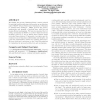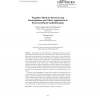151 search results - page 21 / 31 » Secure Human Identification Protocols |
SIGMOD
2003
ACM
14 years 7 months ago
2003
ACM
Finding patterns in large, real, spatio/temporal data continues to attract high interest (e.g., sales of products over space and time, patterns in mobile phone users; sensor netwo...
MOBISYS
2007
ACM
14 years 7 months ago
2007
ACM
We identify the security challenges facing a sensor network for wireless health monitoring, and propose an architecture called "SNAP" (Sensor Network for Assessment of P...
JOC
2007
13 years 7 months ago
2007
In the security chain the weakest link is definitely the human one: human beings cannot remember long secrets and often resort to rather insecure solutions to keep track of their ...
TIFS
2011
13 years 2 months ago
2011
— “Pairing” is the establishment of authenticated key agreement between two devices over a wireless channel. Such devices are ad hoc in nature as they lack any common preshar...
IJACT
2008
13 years 7 months ago
2008
: In the absence of sufficiently optimised public key constructions, anonymous authentication for Radio-Frequency Identification Devices (RFIDs) requires state synchronisation betw...


